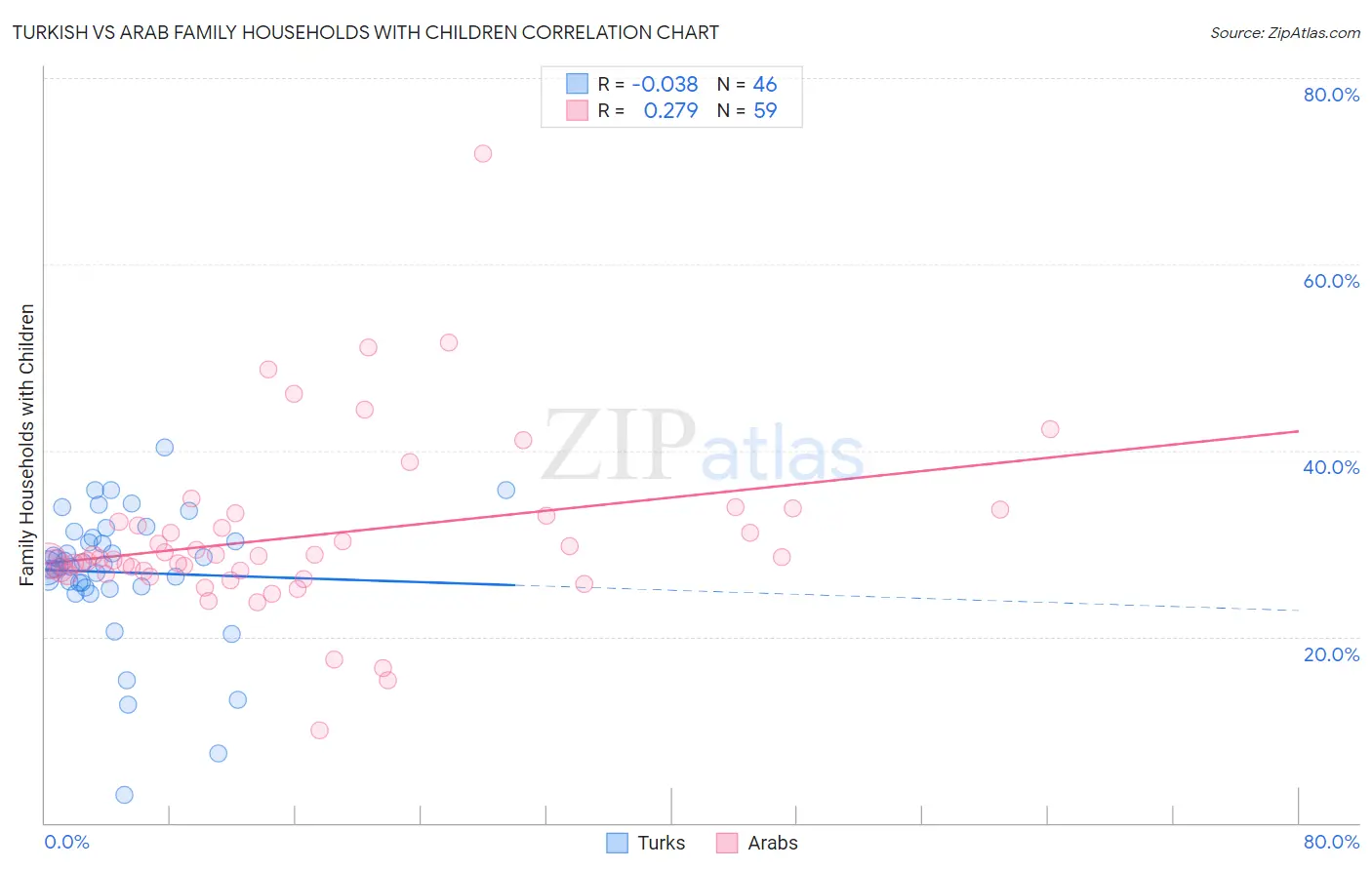Turkish vs Arab Family Households with Children
COMPARE
Turkish
Arab
Family Households with Children
Family Households with Children Comparison
Turks
Arabs
27.4%
FAMILY HOUSEHOLDS WITH CHILDREN
46.9/ 100
METRIC RATING
179th/ 347
METRIC RANK
28.0%
FAMILY HOUSEHOLDS WITH CHILDREN
97.0/ 100
METRIC RATING
113th/ 347
METRIC RANK
Turkish vs Arab Family Households with Children Correlation Chart
The statistical analysis conducted on geographies consisting of 271,630,729 people shows no correlation between the proportion of Turks and percentage of family households with children in the United States with a correlation coefficient (R) of -0.038 and weighted average of 27.4%. Similarly, the statistical analysis conducted on geographies consisting of 486,135,019 people shows a weak positive correlation between the proportion of Arabs and percentage of family households with children in the United States with a correlation coefficient (R) of 0.279 and weighted average of 28.0%, a difference of 2.0%.

Family Households with Children Correlation Summary
| Measurement | Turkish | Arab |
| Minimum | 3.0% | 10.0% |
| Maximum | 40.4% | 71.9% |
| Range | 37.3% | 61.9% |
| Mean | 26.9% | 30.8% |
| Median | 27.6% | 28.6% |
| Interquartile 25% (IQ1) | 25.4% | 26.7% |
| Interquartile 75% (IQ3) | 30.6% | 33.0% |
| Interquartile Range (IQR) | 5.2% | 6.2% |
| Standard Deviation (Sample) | 7.2% | 9.4% |
| Standard Deviation (Population) | 7.1% | 9.4% |
Similar Demographics by Family Households with Children
Demographics Similar to Turks by Family Households with Children
In terms of family households with children, the demographic groups most similar to Turks are Immigrants from Turkey (27.4%, a difference of 0.0%), Aleut (27.4%, a difference of 0.0%), Puget Sound Salish (27.4%, a difference of 0.020%), Spanish American (27.4%, a difference of 0.040%), and Ugandan (27.4%, a difference of 0.050%).
| Demographics | Rating | Rank | Family Households with Children |
| Israelis | 53.9 /100 | #172 | Average 27.5% |
| Immigrants | Argentina | 52.2 /100 | #173 | Average 27.5% |
| Whites/Caucasians | 50.0 /100 | #174 | Average 27.4% |
| British | 49.9 /100 | #175 | Average 27.4% |
| Immigrants | China | 49.6 /100 | #176 | Average 27.4% |
| Ugandans | 49.2 /100 | #177 | Average 27.4% |
| Spanish Americans | 48.9 /100 | #178 | Average 27.4% |
| Turks | 46.9 /100 | #179 | Average 27.4% |
| Immigrants | Turkey | 46.9 /100 | #180 | Average 27.4% |
| Aleuts | 46.7 /100 | #181 | Average 27.4% |
| Puget Sound Salish | 46.2 /100 | #182 | Average 27.4% |
| South Africans | 44.9 /100 | #183 | Average 27.4% |
| Native Hawaiians | 44.6 /100 | #184 | Average 27.4% |
| Delaware | 42.0 /100 | #185 | Average 27.4% |
| Immigrants | Brazil | 40.6 /100 | #186 | Average 27.4% |
Demographics Similar to Arabs by Family Households with Children
In terms of family households with children, the demographic groups most similar to Arabs are Immigrants from Middle Africa (28.0%, a difference of 0.010%), South American Indian (28.0%, a difference of 0.020%), Scandinavian (28.0%, a difference of 0.030%), Immigrants from Africa (28.0%, a difference of 0.030%), and Spaniard (28.0%, a difference of 0.10%).
| Demographics | Rating | Rank | Family Households with Children |
| Immigrants | South America | 98.0 /100 | #106 | Exceptional 28.0% |
| Immigrants | Uganda | 97.7 /100 | #107 | Exceptional 28.0% |
| Immigrants | Burma/Myanmar | 97.7 /100 | #108 | Exceptional 28.0% |
| Tohono O'odham | 97.6 /100 | #109 | Exceptional 28.0% |
| Spaniards | 97.4 /100 | #110 | Exceptional 28.0% |
| Scandinavians | 97.1 /100 | #111 | Exceptional 28.0% |
| Immigrants | Middle Africa | 97.0 /100 | #112 | Exceptional 28.0% |
| Arabs | 97.0 /100 | #113 | Exceptional 28.0% |
| South American Indians | 96.9 /100 | #114 | Exceptional 28.0% |
| Immigrants | Africa | 96.8 /100 | #115 | Exceptional 28.0% |
| Pakistanis | 96.0 /100 | #116 | Exceptional 27.9% |
| Immigrants | Malaysia | 95.9 /100 | #117 | Exceptional 27.9% |
| Central American Indians | 95.9 /100 | #118 | Exceptional 27.9% |
| Zimbabweans | 95.6 /100 | #119 | Exceptional 27.9% |
| Europeans | 95.4 /100 | #120 | Exceptional 27.9% |